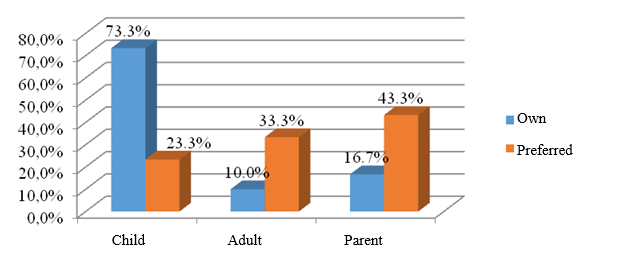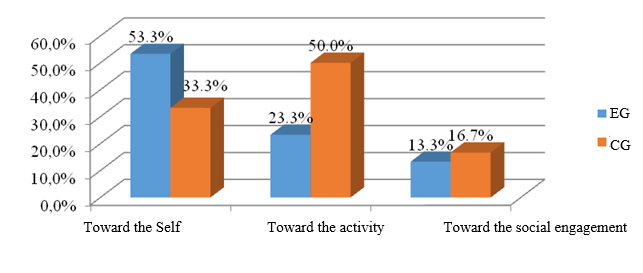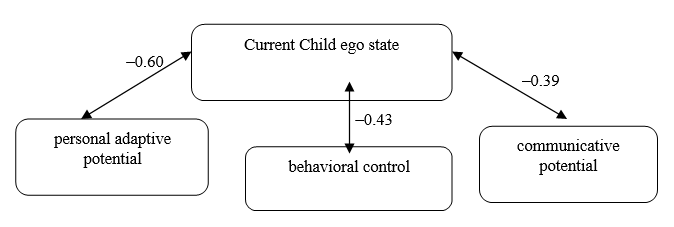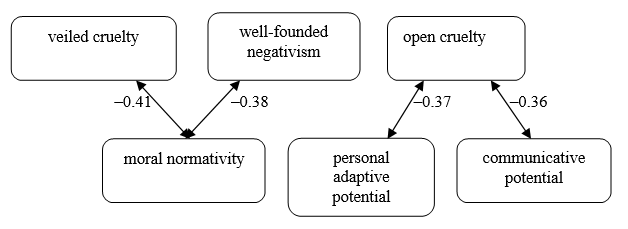Abstract
The paper discusses the outcomes of a study towards communicative attitudes and personal adaptive potential of young people with disabilities. An experimental study was conducted at the club for young disabled people
Keywords: Young persons with disabilitiespersonal adaptive potentialcommunicative attitudes
Introduction
The World Report on Disability of the World Health Organization states that about 15 % of the world’s population has some form of disability.
In Russia, there is a steady trend towards an increased number of people with disabilities, with a growing percentage of young people with disabilities. According to the Federal Service for State Statistics as of January 1, 2017 in our country, there were 552 thousand people with disabilities aged 18 years and older (30), including 319 thousand males and 233 thousand females.
In this regard, one of the directions of state policy in Russia is both the social protection of this social group and the creation of all necessary conditions for their personal and social integration.
According to Alexandrova, Lebedeva and Leontyev (as cited in Lebedeva, 2011, 2012) the development of a person with disabilities is a variant of normal development in ‘difficult conditions’ that necessitate some additional or increased efforts to solve the development tasks facing an individual.
In this context, the way people with special needs are aware of their disability, the Self and others is shaped. Life difficulties, perceived as a challenge posed by life itself, can both impede personal development and contribute to the disclosure of potential capabilities, the activation of inner reserves and resources.
Some researchers consider personal adaptive potential as: an individual, personal property (Maklakov, 2001), as an integrative property expressed in an individual’s attitude (position, mindset, orientation) to the world (Tolstykh, 2011), an integrated education uniting intrapersonal components (Zavatskaya, 2012), an integral variable characterizing the totality of individual signs that determine the effectiveness of mental adaptation (Kuznetsova, 2015).
In modern conditions, most of the challenges experienced by young people with disabilities primarily tend to be of a socio-psychological nature. In this regard, their social integration implies, first of all, the elimination of factors and causes that impede communication, interaction, and self-fulfillment.
The factors that ensure social success for a person are such personality formations that, due to their relationship with social and psychological adaptation, provide the effectiveness of human interaction in society (Koroleva, 2018). These formations include a communicative attitude that has a positive or negative focus. It also has a significant impact on the communicative human behavior as a whole, frames the willingness to respond to certain challenging interactions, including those confusing social conditions that arise when young disabled people communicate.
In early 20th – late 21st centuries, the problems of an individual’s communicative attitude and communicative willingness were repeatedly addressed in both domestic (Galakova, 2013; Ivashov & Zaika, 1991) and foreign studies (Bambacas & Patrickson, 2008; McCroskey, 1995; McCroskey & Richmond, 1987; Sallinen-Kuparinen et al., 1991). Moreover, in foreign publications, most often communicative attitudes are considered as a condition for achieving individual success, social and psychological adaptation, including that in a professional environment (Bambacas & Patrickson, 2008; Kinnick & Parton, 2005).
According to Galakova (2013), a positive communicative attitude is a holistic dynamic state of the agent of communication, which is characterized by positive self-attitude, willingness to be active toward other communicants and the process of communication as such, which is associated with the emotional experience of their social and personal value.
Accordingly, a bad attitude reflects the readiness to be hostile to most people around. It is formed as a result of pronounced negative emotions induced by a bad experience of human interaction. Fixed good or bad personal attitudes arise as the individual develops when, affected by the social environment, a hierarchical framework of significant objects and social phenomena and significant personality relationships is formed. Manifesting and gaining a foothold, significant relationships become more stable over time. In fact, they become character traits (Bodalev, 2011).
As for persons with disabilities, the most important source of forming the communicative mindset is the position of their family, the degree to which parents accept their child with special needs. As a rule, parents raising children with disabilities tend to be overprotective, which distorts the formation of future communicative attitudes in people with disabilities.
Problem Statement
The study was aimed at the following tasks:
To investigate experimentally the features of structural components that make up the personal adaptive potential and communicative attitudes of young people with disabilities.
To carry out a correlation analysis of structural components that make up the personal adaptive potential and communicative attitudes of young people with disabilities.
Research Questions
-
To compare the characteristics and level of personal adaptive potential, behavioral control, communicative potential, moral normativity of young disabled and non-disabled people.
-
To identify and describe the prevailing type of ego states and communicative attitudes in the experimental and control groups.
-
Based on mathematical statistics, to confirm or deny the relationship between the structural components of personal adaptive potential and communicative attitudes in young people with disabilities.
Purpose of the Study
The empirical study implied identifying the nature of the relationship between personal adaptive potential and communicative attitudes in young people with disabilities.
The following hypotheses were put forward:
the level of personal adaptive potential of young disabled people is lower than that of young non-disabled people, primarily in the field of communication and behavior;
negative communicative attitudes will prevail among young people with disabilities, including marked orientation toward the Self, which is due to parents’ overprotection;
the positive communicative Adult and Parent states as well as orientation toward the activity performed are supposed to mediate high adaptive abilities of young disabled people, whereas negative communicative attitudes consisting in veiled and open cruelty, well-founded negativism, orientation toward the Self are supposed to mediate low adaptive abilities among young disabled people.
Research Methods
The following methods were used in the study: multi-level personality questionnaire
For statistical analysis, the following methods were used: comparative statistics (Student’s t-test), frequency analysis (Fisher transformation), and correlation analysis (Pearson’s chi-squared test).
The study involved young people with disabilities aged 19–25 years with preserved intelligence (EG). The control group (CG) was a random sample of peers with normative development. The total number of participants was 60 people. Young people with disabilities attend the club Preodolenie, housed by the Center for Children and Youth named after V.P. Polyanichko, Orenburg.
Findings
Quantitative indicators in Personal adaptive potential, Behavioral control, Communicative potential, Moral normativity based on the multi-level personality questionnaire Adaptability (MPQ-A) by Maklakov (2001) and Chermyanin (1993) are presented in Figure
![The average of the indicators in EG and CG based on the questionnaire Adaptability) [PAP – Personal adaptive potential, BC – Behavioral control; CP – Communicative potential; MN – Moral normativity]](https://www.europeanproceedings.com/files/data/article/10040/11637/SCTCMG2020FA104.fig.001.jpg)
The figures above justify that the participants in the EG showed lower behavioral control than those in the CG (4.1 compared to 6.2) and, accordingly, their personality adaptive potential is significantly lower. This indicates that the participants in the EG have emotional instability, exhaustion, and inertia. Unlike the participants in the CG, they fail to show resistance to external circumstances and inadequately perceive reality.
The average indicator in the communicative potential also differs significantly (4.1 compared to 6.5). Many EG respondents experience difficulties in socializing, characterized by conflict and violent behavior. Unlike the EG respondents, the majority of CG respondents have well-developed communicative abilities. They willingly get on well with others. Some conflict and violent behavior can arise, though.
Moral normativity is mostly similar in both groups (5.3 compared to 6.3). This indicates that a common feature for almost all respondents in both groups is the ability to adequately perceive their social role, to accept moral standards of behavior and, accordingly, to understand the requirements of the immediate circle. The CG respondents demonstrated a high level of self-possession or desire to show themselves in the best light. Meanwhile, many EG respondents demonstrated a low level of socialization, an inadequate evaluation of their own significance in the group, and a lack of desire to comply with uniform moral behaviors. Therefore, based on the data, the EG respondents are believed to depend on some external conditions for successful adaptation, and not on their personal characteristics. Perhaps, for this reason, they are unlikely to assume commitment for certain transformations that they ‘author’.
The analysis suggests that young people with disabilities have lower indicators of personal adaptive potential, compared with young non-disabled people.
The results obtained through the method of Ivashov and Zaika (1991) showed that 73.3 % of young people with disabilities are in their Child ego state, 16.7 % of the respondents are in their Parent ego state, and 10 % – in the Adult state.
The Parent part is determined to be the preferred ego state with the largest percentage of 43.3 %. The Adult and Child states – 33.3 and 23.3 %, respectively (Figure

The generalized results of the study into control and experimental samples through the diagnosis of the communicative mindset by Boyko (2005) are presented in Figure
![The degree of communicative parameters in CG and EG (% to maximum points) [VC – veiled cruelty, OC – open cruelty, WN – well-founded negativism, Gr – grumbling, BE – bad experience, CA – general negative communicative attitude]](https://www.europeanproceedings.com/files/data/article/10040/11637/SCTCMG2020FA104.fig.003.jpg)
The bad communicative attitude in the control group is boundary, i.e. the sample contains the respondents with both negative and positive communicative mindsets (33.6 %), while in the experimental group the communicative attitude is exceeding (38.7 %). Accordingly, the sample contains the respondents mainly with negative attitudes.
Based on the results in Figure
The control group showed a higher level of open cruelty towards other people (29 % in CG compared to 24.8 % in EG).
Both samples are characterized by well-founded negativism, reluctance to communicate, and separation trends. The difference is in the form of response: the experimental group has a passive position, while the control group has an active, open position. The EG passive position is probably due to the inferiority complex based on the awareness of the limitations and disabilities.
The level of grumbling is reasonably higher in the experimental group (51.7 % in the EG compared to 32 % in the CG).
The level of bad experience is reasonably higher in the experimental group (46.2 % compared to 24.3 % in the CG).
The data based on Bass Orientation Inventory outline a correlation between the manifestations of personality orientation (Figure

The EG participants predominantly demonstrated the orientation toward the Self (53.3 %), slightly less – the orientation toward the activity performed (23.3 %) and the social engagement (13.3 %).
In the CG, the dominant type of personality orientation was the orientation toward the activity (50 %), then toward the Self (33.3 %), and then toward the social engagement (16.7 %).
It is noteworthy that personal orientation toward the social engagement is represented in both groups to the least extent.
To assess the reliability of the differences disclosed, the results were analyzed through the Fisher transformation (Table
The study provided the following results:
Unlike non-disabled young people, young people with disabilities have lower personal adaptive potential ( ). They also have lower levels of behavioral control ( ) and communicative potential ( ), which confirms the first hypothesis of the study. The study showed that the maladjustment rate in the disabled (visual impairment) is significantly higher ( ), i.e. they are more prone to anxiety, avoidance of problems and difficulties, low self-esteem, lack of independence and self-confidence, self-doubt, etc.
The Child ego state prevails ( ) in the group of young disabled people. They are less likely to be in the Parent state ( ). The predominant type of communication in this sample is ‘walled off’. Young disabled people have a pronounced negative communicative attitude ( ), grumbling ( ) and a prevailing bad experience ( ). Young people with disabilities have the orientation toward the Self ( ) as a dominant type. These results confirm the second hypothesis of the study.
Pearson’s chi-squared test was used to examine the relationship between adaptive abilities and communicative attitudes in young people with disabilities.
The qualitative values were transformed into quantitative ones to analyze the correlation between the ego state and personal adaptive potential. The Child value was taken as 3, the Adult value – 2, the Parent value – 1. A negative correlation was found between the current Child ego state and adaptability parameters (Figure

The study found that a pronounced current Child ego state results in a decrease in personal adaptive potential (r= –0.6, 0.01), behavioral control (r= –0.43, ) and communicative potential (r= –0.39, ).
The study revealed a positive correlation between the desired ego state and moral normativity ((Figure
In particular, the more the young disabled person is guided by the ideals of the adult and the parent, the more critical he/she is to assess his/her role in the team, and to meet uniform moral behaviors. This is natural, because it is the adult and the parent states that presuppose the orientation toward norms and rules.
The study leads to the conclusion that negative communicative attitudes are inversely related to adaptability parameters (Figure

Thus, high veiled cruelty and well-founded negativism are inversely related to moral normativity (r=–0.41 and r=–0.38, ). Veiled cruelty implies reserved demeanor, double morals: one – for others (“I am good to others”), the other – for the Self (“Inside I am cruel”). This, accordingly, reduces the importance of moral standards and rules for young people with disabilities.
The correlation analysis found that orientation toward the Self is inversely related to moral normativity (Figure

It is likely that self-centeredness creates the conditions for declining moral normativity. This implies that high adaptability is interconnected with positive communicative attitudes (Adult and Parent states, with the orientation toward the activity) and inversely related to negative communicative attitudes (veiled and open cruelty, well-founded negativism, orientation toward the Self), which proves the third hypothesis of the study.
Conclusion
Having studied experimentally the features of personal adaptive potential and communicative attitudes of young disabled people (EG), and compared the data with conditionally healthy peers (CG), the authors found that:
both groups have a similar level of moral normativity within personal adaptive potential. The differences in the predominance of the Adult ego state in the CG and the orientation toward the social engagement are not proved. Both groups have the same level of veiled cruelty and well-founded negativism;
young people with disabilities have much lower adaptability, including behavioral control ( ), communicative potential ( ), and personal adaptive potential ( );
young people with disabilities have negative communicative attitudes, including the Child ego state ( ), orientation toward the Self ( ), grumbling, bad communication experience ( ) and general negative communicative attitude ( );
negative communicative attitudes are associated with low personal adaptive potential. Moreover, the most significant inverse relationship with personal adaptive potential were found between the ego Child state, orientation toward the Self, high veiled and open cruelty, and well-founded negativism. The excessive orientation toward the Self, the desire for constant care and tutelage, and an infantile position complicates the activity (as it implies passivity, dependence) and entails the disruption of social connections (as it involves egocentrism). Probably, instead of overcoming the difficulties related to social engagement, the identified features make the disabled go with maladaptive forms of behavior. Veiled and open cruelty, grumbling reduce the willingness to overcome socialization difficulties, increase the risk of destructive attitudes;
positive communicative attitudes are associated with high personal adaptive potential. Moreover, the most significant relationship is between the current and desired ego states (Adult, Parent) and orientation toward the activity. Perhaps a more mature ego state, both current and desired, and orientation toward the activity help a young disabled person overcome the difficulties encountered in activities and communication.
Finally, the relevance of the study into the psychological relationship between personal adaptive potential and communicative attitudes of young people with disabilities is confirmed by a correlation relationship.
Based on the empirical study, it is recommended to work with a current ego state to increase the adaptive abilities of young people with special needs, through the conditions for adopting the Adult or Parent state to make young people with disabilities look to some activity and reduce the manifestations of negative communicative attitudes through the analysis and reassessed importance of bad communication experience.
The development of personal adaptive potential and the formation of positive communicative attitudes in young people with disabilities can be more efficiently achieved through an integrative approach, the synthesis and use of various methods and techniques of cognitive-behavioral, narrative psychotherapy and psychocorrection, art methods, social and psychological training with regard to age-related characteristics.
The experience of the club Preodolenie for young people with disabilities, housed by the Orenburg Regional Center for Children and Youth named after V.P. Polyanichko, proved that the inclusive space of this educational organization contributes to the formation of positive communicative attitudes.
References
- Bodalev, A.A. (2011). Psychology of Communication. Encyclopedia. Kogito Center.
- Boyko, V. V. (2005). Method for diagnosing the communicative mindset. Mysl.
- Bambacas, M., & Patrickson, M. (2008). Interpersonal communication skills that enhance organizational commitment. J. of Communicat. Manag., 12, 51–72.
- Chermyanin, S.V. (1993). Methodological Aspects of Psychological And Pedagogical Support of Students. Mysl.
- Galakova, M. V. (2013). On the formation of positive communicative attitude in the learning process. http://cyberleninka.ru/article/n/k-voprosu-o-formirovanii-pozitivnoy-kommunikativnoy-ustanovki-v-protsesse-professionalnoy-podgotovki
- Ivashov, A. N., & Zaika, E. V. (1991). Research Methods for Person’s Communicative Attitudes. Quest. of Psychol., 5, 162–166.
- Kinnick, K. N., & Parton, S. R. (2005). Workplace communication. Busin. Communicat. Quarterly, 68, 429–456.
- Koroleva, Y. A. (2018). Expert assessment of the socio-psychological competence of special needs adolescents. Russ. Psycholog. J., 15(4), 8–29.
- Kuznetsova, L. E. (2015). Improving students’ adaptive potential in the process of psychological support. moluch.ru/archive/103/24095/
- Lebedeva, A. A. (2011). Specificity of resources and mechanisms of psychological stability of students with disabilities in inclusive education. Psycholog. Sci. and Ed., 3, 80–94.
- Lebedeva, A. A. (2012). Subjective well-being of persons with disabilities. http://nauka-pedagogika.com/psihologiya-19-00-01/dissertaciya-subektivnoe-blagopoluchie-lits-s-ogranichennymi-vozmozhnostyami-zdorovya#ixzz3iKe223Wx
- Maklakov, A. G. (2001). Personal adaptive potential: its mobilization and prognostication in extreme conditions. Psycholog. J., 1, 16–2.
- McCroskey, J. (1995). Communication Research Reports: A new beginning. Communicat. Res. Reports, 12, 1–2.
- McCroskey, J., & Richmond, V. (1987). Willingness to Communicate. In J. C. McCroskey, & J. A. Daly (Eds.), Personality and Interpersonal Communication. Sage, Newbury Park.
- Sallinen-Kuparinen, A., McCroskey, J., & Richmond, V. (1991). Willingness to Communicate, Communication Apprehension, Introversion, and Self-Reported Communication Competence: Finnish and American comparisons. Communicat. Res. Reports, 8, 55–64.
- Tolstykh, Y. I. (2011). Modern approaches to the category of adaptive potential. The Humanities, 1, 493–496.
- Zavatskaya, N. E. (2012). The level of person’s adaptive potential as a component of social readaptation during a crisis. file:///C:/Users/User/Downloads/22%20(1).pdf
Copyright information

This work is licensed under a Creative Commons Attribution-NonCommercial-NoDerivatives 4.0 International License.
About this article
Publication Date
27 October 2020
Article Doi
eBook ISBN
978-1-80296-091-4
Publisher
European Publisher
Volume
92
Print ISBN (optional)
-
Edition Number
1st Edition
Pages
1-3929
Subjects
Sociolinguistics, linguistics, semantics, discourse analysis, translation, interpretation
Cite this article as:
Nasibullina, A., Koroleva, J., & Polshina, M. (2020). Analysis Of Relationship Between Communicative Attitudes And Adaptive Potential Of Disabled Youth. In D. K. Bataev (Ed.), Social and Cultural Transformations in the Context of Modern Globalism» Dedicated to the 80th Anniversary of Turkayev Hassan Vakhitovich, vol 92. European Proceedings of Social and Behavioural Sciences (pp. 773-783). European Publisher. https://doi.org/10.15405/epsbs.2020.10.05.104

